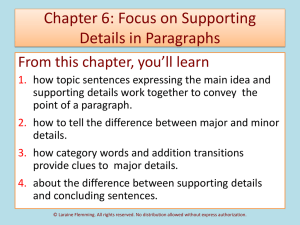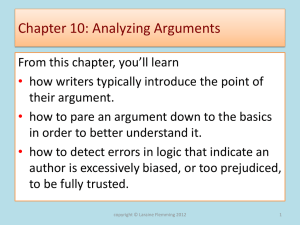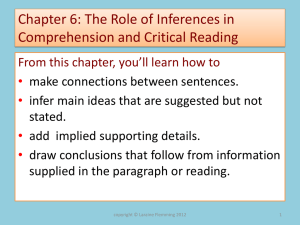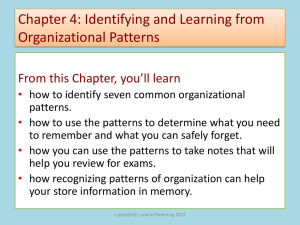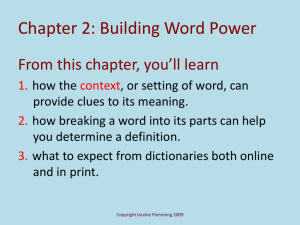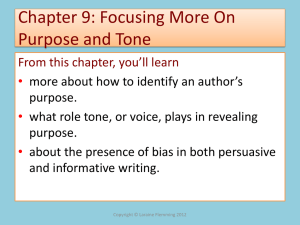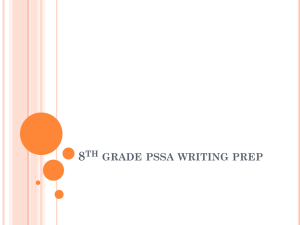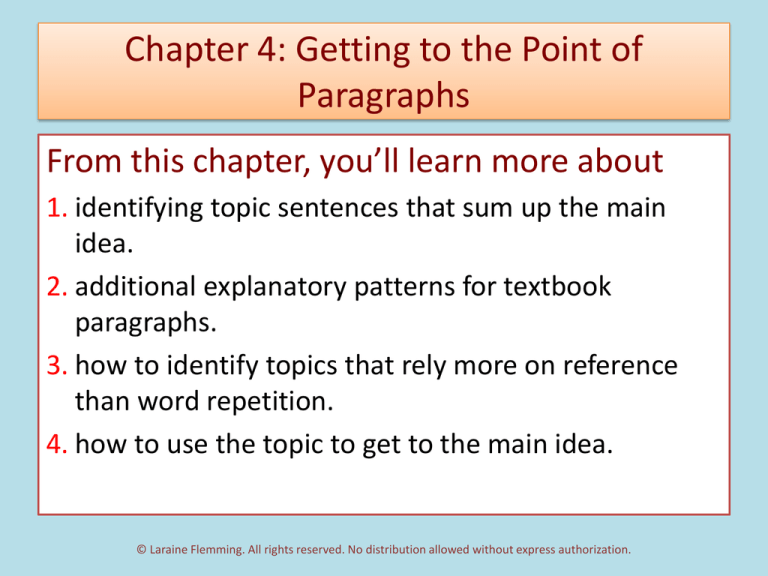
Chapter 4: Getting to the Point of
Paragraphs
From this chapter, you’ll learn more about
1. identifying topic sentences that sum up the main
idea.
2. additional explanatory patterns for textbook
paragraphs.
3. how to identify topics that rely more on reference
than word repetition.
4. how to use the topic to get to the main idea.
© Laraine Flemming. All rights reserved. No distribution allowed without express authorization.
Additional Ways Authors Introduce Topic
Sentences
• Chapter 3 introduced three common locations for
topic sentences.
• This chapter tells you about more about other
locations and other patterns for introducing topic
sentences.
•
•
•
•
1. That was Then, This is Now
2. Moving toward the Middle
3. Doubling Up on Topic Sentences
4. Introductory Questions followed by Topic Sentence
Answers
© Laraine Flemming. All rights reserved. No distribution allowed without express authorization.
Paragraph Pattern 1: That was Then, This
is Now
This explanatory pattern is characterized by
1. an introductory sentence (or sentences) that say how things
have been done or what has been assumed or thought for a
long time.
2. a topic sentence that challenges previous thinking and
suggests that there is a new way of doing things.
3. supporting details that match up with the new way of
thinking rather than the old.
Based on that description, where is the topic sentence in this
paragraph?
© Laraine Flemming. All rights reserved. No distribution allowed without express authorization.
That Was Then, This is Now
1For
centuries, frogs have seemed to be Earth’s ultimate survivors,
creatures capable of surviving any form of natural disaster. 2But
now frogs are under attack. 3If something is not done fast, frogs
may become extinct. 4Already, almost one-third of all frog species
have vanished. 5In addition to the human invasion of frog habitats
and the ills brought on by air pollution, frogs are being plagued by
a mysterious fungus, which plugs their pores and leaves them to
suffocate. 6Amphibian experts all over the world are trying to find
a cure for the fungus before frogs disappear from the face of the
earth. 7In parts of Central America, some frogs have been
completely removed from their natural habitat and transported to
new locations. 8The goal is keep the healthy frogs safe from the
fast-traveling chytrid fungus that has already destroyed entire
species of frogs.
© Laraine Flemming. All rights reserved. No distribution allowed without express authorization.
Paragraph Pattern 2: Moving Toward the Middle
This explanatory pattern is characterized by
1. paragraphs that start off with a number of specific details, which
provide background, pose questions, or offer illustrations.
2. A shape that balloons in the middle when the topic sentence
arrives, only to slim down again following the topic sentence.
3. several introductory sentences that push the topic sentence to the
middle of the paragraph.
Based on that description where is the topic sentence in this
paragraph?
© Laraine Flemming. All rights reserved. No distribution allowed without express authorization.
Moving Toward the Middle
1Are
you one of those people who think professional athletes
should quit their sport by age thirty? 2Should they abandon their
sport before physical decline sets in? 3What’s the point, after all,
of aging athletes trying to beat opponents ten years younger? 4Isn’t
it hopeless and pathetic? 5If you are one of those people inclined
to scoff at older athletes, you need to consider what some of them
have achieved despite their age. 6In 1991 baseball great Nolan
Ryan pitched a no-hitter against the Toronto Blue Jays. 7At the time,
he was forty-one. 8In 2003, at the ripe old age of forty-six, tennis
player Martina Navratilova won two mixed-doubles crowns, one at
Wimbledon and another at the Australian Open. 9In the 2008
Olympics, no one expected much from forty-one-year-old swimmer
Dara Torres, but to everyone’s shock, she became the oldest
woman to ever medal at the Olympics.
© Laraine Flemming. All rights reserved. No distribution allowed without express authorization.
The Importance of Paying Attention
to Reversal Transitions
•
Often when the second or third sentence of a paragraph is the
topic sentence, the author will signal its presence with a reversal
transition.
•
Transitions such as however, but, on the contrary, unfortunately,
nevertheless, and despite that fact are all examples of reversal
transitions.
•
They all signal that the writer is changing gears and moving away
from the opening train of thought in a paragraph.
© Laraine Flemming. All rights reserved. No distribution allowed without express authorization.
If reversal transitions are clues, where’s
the topic sentence in this paragraph?
1Experienced
divers know about the beauty of the sea. 2They
know about its glorious colors and rhythmic movement. 3But
deep sea divers also know that the sea has its dangers, like the
potentially deadly sting ray. 4Lying almost completely covered
by sand on the ocean floor, the stingray reacts instantaneously
to the touch of a human foot or hand. 5In response to that
touch, the stingray whips its tail around and plants a sharp
poisonous spine in the diver’s flesh. 6In addition to intense
pain, the poison can cause nausea, diarrhea, a dangerous drop
in blood pressure and sometimes death. 7Although there have
been cases of stingrays becoming accustomed to humans who
feed them, the best rule is “Diver Beware”!
© Laraine Flemming. All rights reserved. No distribution allowed without express authorization.
Doubling Up on Topic Sentences
This explanatory pattern is characterized by
1. a topic sentence at the beginning of the paragraph.
2. a topic sentence at the end.
3. two sentences that sum up the general point of the
paragraph.
So in your own words, what is the main idea or general point of
this double topic sentence paragraph?
© Laraine Flemming. All rights reserved. No distribution allowed without express authorization.
Dragonflies have a somewhat intimidating appearance,
but don’t hold that against them; they are very beneficial
to humans because they keep down the insect
population. Dragonflies have huge eyes and an elongated
body, topped off with a double pair of wings. Found
around water, dragonflies do not sting, but their scary
appearance still encourages humans to pull out the
insect spray at the first sight of the fluttering creatures.
That’s a mistake, however, because dragonflies eat
mosquitoes, which are found around water, and
mosquitoes breed dangerous diseases from West Nile
virus to Malaria. Keeping the mosquito population down
is one of the dragonflies great virtues, and it does a lot
to make up for their appearance.
© Laraine Flemming. All rights reserved. No distribution allowed without express authorization.
© Ulrich Flemming
If you see one, remember, hands off the bug spray.
© Laraine Flemming. All rights reserved. No distribution allowed without express authorization.
Introductory Questions Can Replace
Introductory Sentences
•
Sometimes authors replace introductory sentences with
introductory questions.
•
When they do, you need to look for the answer, which is
likely to be the topic sentence.
•
That answer can follow immediately, but it can also take a
while to arrive.
© Laraine Flemming. All rights reserved. No distribution allowed without express authorization.
Where’s the topic sentence in this paragraph?
Do people vary in their need for stimulation? Picture a city
dweller who is visiting the country. Before long, she begins to
complain that it is too quiet. Now imagine a country dweller
who who is visiting the city. Very soon she finds the city
“overwhelming” and seeks peace and quiet. These examples
are extremes but they suggest that people learn to seek
particular levels of arousal.
(Adapted from Dennis Coon and John O. Mitterer Introduction to Psychology 12e,p. 330.)
© Laraine Flemming. All rights reserved. No distribution allowed without express authorization.
Turning Again to the Topic
Just to review, the topic of the paragraph
• is the subject under discussion.
• answers the question: “What person, place, event,
or thing is the author discussing?”
• is the starting point for discovering the reading’s
main idea, or central thought.
• is repeated and referred to throughout the
passage.
• is expressed in a single word or brief phrase.
© Laraine Flemming. All rights reserved. No distribution allowed without express authorization.
Sometimes finding the topic is a no-brainer. A word or phrase is
repeated so often, you couldn’t miss the topic if you wanted to.
The Mandrake is a plant found in regions near
the Mediterranean. It has a short stem and
purple or white flowers. The Mandrake is said
to have healing powers, among them the ability
to induce sleep and revive sexual desire. In large
doses, however, the Mandrake is said to cause
madness and delirium.
• Did you guess that the Mandrake is the topic?
© Laraine Flemming. All rights reserved. No distribution allowed without express authorization.
But what about here? Is the topic still so
obvious? Is it Eisenhower or Warren?
When Dwight D. Eisenhower nominated Earl Warren to be
Chief Justice of the Supreme Court in 1958, he thought he was
putting a very conservative judge in place, who would be
unlikely to promote dramatic changes in the legal system.
Warren, however, turned out to be anything but conservative.
It was he who pushed through ground-breaking civil rights
legislation in 1954 and made the protection of individual
liberties a passionate cause throughout his long career. As
head of the Supreme Court for sixteen years, Warren was
considered an “activist” judge who openly pursued a liberal
agenda—much to Eisenhower’s surprise and shock.
© Laraine Flemming. All rights reserved. No distribution allowed without express authorization.
Any one of the following topics would be correct.
• Earl Warren’s years on the Supreme Court
• Earl Warren’s role as Supreme Court Justice
• The liberalism of Chief Justice Earl Warren
But the question you need to be asking now is why?
© Laraine Flemming. All rights reserved. No distribution allowed without express authorization.
Any one of those phrases is correct because
1. the writer repeats and refers to the subject of Earl Warren as the
liberal Chief Justice of the Supreme Court.
2. the references to Warren as a Supreme Court judge appear from
beginning to end.
3. the references to Eisenhower dwindle toward the end.
4. the references to Warren often appear in sentence openings, a
typical place for topic references to appear.
• That chain of repetition and reference is what makes “Earl
Warren’s years on the Supreme Court,” (or a similar phrase), the
topic of the paragraph.
© Laraine Flemming. All rights reserved. No distribution allowed without express authorization.
Note the number of references to Warren as Supreme
Court head versus the references to Eisenhower.
When Dwight D. Eisenhower nominated Earl Warren to be
Chief Justice of the Supreme Court in 1958, he thought he was
putting a very conservative judge in place, who would be
unlikely to promote dramatic changes in the legal system.
Warren, however, turned out to be anything but conservative.
It was he who pushed through ground-breaking civil rights
legislation in 1954 and made the protection of individual
liberties his personal cause throughout his long career. As
head of the Supreme Court for sixteen years, Warren was
considered an “activist” judge who openly pursued a liberal
agenda—much to Eisenhower’s surprise and shock.
© Laraine Flemming. All rights reserved. No distribution allowed without express authorization.
© Ulrich Flemming
A Word to the Wise
The author doesn’t always identify the topic through
repetition of the exact same word or phrase. Instead,
• the topic is threaded throughout the paragraph by a
combination of straight repetition and the use of topic
stand-ins or substitutes.
• Those topic substitutes can take many different forms,
i.e., pronouns, synonyms, examples, and related words.
© Laraine Flemming. All rights reserved. No distribution allowed without express authorization.
Don’t stop with the topic. Keep looking for the main idea.
What other chain of repetition and reference do you see?
When Dwight D. Eisenhower nominated Earl Warren to be
Chief Justice of the Supreme Court in 1958, he thought he
was putting a very conservative judge in place, who would
be unlikely to promote dramatic changes in the legal
system. As a Supreme Court judge, however, Warren
turned out to be anything but conservative. It was he who
pushed through ground-breaking civil rights legislation in
1954 and made the protection of individual liberties his
personal cause throughout his long career. As head of the
Supreme Court for sixteen years, Warren was considered
an “activist” judge who openly pursued a liberal agenda—
much to Eisenhower’s surprise and shock.
© Laraine Flemming. All rights reserved. No distribution allowed without express authorization.
Does this main idea match the
chains of repetition and reference?
• Dwight D. Eisenhower was outraged when he
discovered that Earl Warren was not the
conservative he thought he had selected for
the Supreme Court.
© Laraine Flemming. All rights reserved. No distribution allowed without express authorization.
What about this main idea? Is it a match?
• Earl Warren may have been a conservative
when he was picked for the Supreme Court,
but on the bench he became a flaming liberal.
© Laraine Flemming. All rights reserved. No distribution allowed without express authorization.
Now that you have the main idea, can you find a topic sentence
that says much the same thing?
1When
Dwight D. Eisenhower nominated Earl Warren to be Chief
Justice of the Supreme Court in 1958, he thought he was putting
a very conservative judge in place, who would be unlikely to
promote dramatic changes in the legal system. 2As a Supreme
Court judge, however, Warren turned out to be anything but
conservative. 3It was he who pushed through ground-breaking
civil rights legislation in 1954 and made the protection of
individual liberties his personal cause throughout his long career.
4As head of the Supreme Court for sixteen years, Warren was
considered an “activist” judge who openly pursued a liberal
agenda—much to Eisenhower’s surprise and shock.
© Laraine Flemming. All rights reserved. No distribution allowed without express authorization.
© Ulrich Flemming
Just So You Know
Eisenhower was so upset about how liberal Warren
turned out to be, he is said to have called Warren’s
appointment the “biggest damned fool mistake I ever
made.” Among Warren’s landmark decisions were
Brown v. Board of Education, which banned segregation
in public schools, and Miranda v. Arizona, which made it
illegal for the police to take people into custody without
notifying them of their rights, particularly their right to
an attorney.
© Laraine Flemming. All rights reserved. No distribution allowed without express authorization.
Different Texts Require Different Approaches
Remember the advice in Chapter 1 about being a flexible
reader? It certainly applies to how you determine the topic,
main idea, and topic sentence.
•
In business texts, topic sentences are most likely to head
up the paragraph.
•
In history texts, first position is powerful but so too is the
implied main idea, where you, the reader, have to put the
pieces together to construct a main idea statement.
•
Psychology texts often use questions to point readers in
the right direction.
© Laraine Flemming. All rights reserved. No distribution allowed without express authorization.
© Ulrich Flemming
A Word to the Wise
Don’t focus solely on word or phrase
repetition when trying to determine the topic.
Instead, look for words, pronouns, examples,
synonyms, and associations that are linked
together to form a chain of repetition and
reference. A chain of repetition and reference
is what links the sentences in a paragraph
together and, at the same time, reveals the
topic and main idea.
© Laraine Flemming. All rights reserved. No distribution allowed without express authorization.
For a quick review
The topic should
1. be repeated and referred to throughout the
paragraph.
2. answer the question, “What person, place,
event, or thing is the author describing?”
3. be referred to in a variety or ways, through
pronouns, synonyms, examples, associated
words, and suggestions.
© Laraine Flemming. All rights reserved. No distribution allowed without express authorization.
The Main Idea
• answers the question: “What does the author
want to say about the topic?”
• is explained or proven by most of the other
sentences in the paragraph.
• is expressed in a sentence rather than a single
word or a phrase.
• can be expressed in any number of ways but
always sums up the point of the paragraph.
© Laraine Flemming. All rights reserved. No distribution allowed without express authorization.
© Ulrich Flemming
A Word to the Wise
Any number of readers can “language” the main idea in any
number of ways, but only the author writes a topic sentence. If
the author’s topic sentence leaps out at you when you read,
great. But don’t obsess about it. Keep trying to use the author’s
language to determine the main idea in your own words. Once
you get a handle on the main idea, the topic sentence will
become more obvious.
© Laraine Flemming. All rights reserved. No distribution allowed without express authorization.
To understand the difference between the topic and
the main idea, here are three topics:
1. Wikipedia
2. Facebook
3. Vaccines against Bird Flu
© Laraine Flemming. All rights reserved. No distribution allowed without express authorization.
Here Are Three Possible Main Ideas:
1. Software now exists that can identify who
makes changes to Wikipedia’s entries.
2. More and more employers are blocking
employees from accessing Facebook at work.
3. Many drug companies are working hard to
develop a vaccine against bird flu.
© Laraine Flemming. All rights reserved. No distribution allowed without express authorization.
Here are the Three Main Characteristics of a
Topic Sentence:
1. It’s one of the most general sentences in the
paragraph.
2. Just about every other sentence in the
paragraph develops it.
3. It could be used to answer the question,
“What’s the point of the paragraph?”
© Laraine Flemming. All rights reserved. No distribution allowed without express authorization.
© Ulrich Flemming
A Word to the Wise
Determining if a paragraph does or does not have
a topic sentence is an important skill. If you find
the topic sentence, you can paraphrase it for your
notes and be sure you have summed up the
paragraph. BUT that does not mean you hold off
thinking about the paragraph’s point until you hit
upon the topic sentence. You should be trying to
determine the topic and main idea from the very
first sentence, using the clues left by the author.
© Laraine Flemming. All rights reserved. No distribution allowed without express authorization.
© Ulrich Flemming
Finishing Up: Getting to the Point of
Paragraphs
You’ve previewed the major concepts
and skills introduced in Chapter 4.
Take this quick quiz to test your
mastery of those skills and concepts,
and you are ready to read the
chapter.
© Laraine Flemming. All rights reserved. No distribution allowed without express authorization.
Finishing Up: Getting to the Point of Paragraphs
1. True or False. Words or phrases expressing
the topic of a paragraph are likely to appear
at the beginning of sentences.
2. True or False. If a person, place or event is
repeated and referred to in the beginning of
the paragraph but not at the end, it’s still
likely to be the topic of the paragraph.
© Laraine Flemming. All rights reserved. No distribution allowed without express authorization.
Finishing Up: Getting to the Point of Paragraphs
3. True or False. The term chain of repetition and
reference describes the way authors keep
certain ideas in the forefront of the reader’s
mind.
4. True or False. The “that was then, this is now
paragraph” starts off by telling readers what
people once thought before telling them what
they think now.
© Laraine Flemming. All rights reserved. No distribution allowed without express authorization.
Finishing Up: Getting to the Point
of Paragraphs
5. When writers want to make sure readers don’t miss
the point, they sometimes repeat the main idea in which
two places?
6. True or False. When the author opens a paragraph
with a question, the answer always follows right on the
heels of the question and expresses the main idea.
© Laraine Flemming. All rights reserved. No distribution allowed without express authorization.
7. What’s the main idea in this paragraph? Which
sentence is the topic sentence? What clue gives away
the topic sentence?
1Bullying
in high schools and elementary schools is a much
discussed topic, yet many parents feel that they don’t
know whether their child is being bullied.2They just can’t
tell.3However, there are often visible signs that indicate a
child is being bullied, and parents should be alert to them.
4A child might be the object of bullying if he or she comes
home from school with unexplained bruises or cuts.
5Bullying might also be why a child suddenly shows no
interest in school work.6Another sign is a child’s resistance
to talking about school and signs of moodiness or tears
upon returning home from school.7The sudden onset of
insomnia when school starts is yet another indication that
a child is being bullied.
© Laraine Flemming. All rights reserved. No distribution allowed without express authorization.
8. Which one of the following paragraphs has a
double topic sentence?
a. Lydia Sherman’s life was never the subject of a horror film. But
it could have been. In the late nineteenth century, Lydia
Sherman, a demure housewife, almost got away with multiple
murders. Sherman poisoned three husbands and six children.
However she managed to escape detection until she had
murdered her fourth husband. The doctor in attendance was
not so willing to assume a woman could not commit murder.
When Lydia’s husband died under mysterious circumstances,
the good doctor ordered an autopsy and discovered that the
dead man had died of arsenic poisoning. Lydia tried to get
away but detectives tracked her down, and she went to jail for
life, after admitting that she had killed eleven people.
© Laraine Flemming. All rights reserved. No distribution allowed without express authorization.
b. 1These days everyone seems to have a phobia of one
sort or another.2For some people it’s fear of
elevators.3For others, it’s flying. 4Then there are the
people who won’t leave their houses or who can’t stand
the thought of being in crowds.5For a few, the fear is of
water.6For many more, it’s fear of heights, and scaling
Mount Everest would be a nightmare rather than a
thrilling challenge. 7Although some phobias are more
obvious than others, modern life seems to encourage
them, because everyone has one, even if they don’t
admit it.
© Laraine Flemming. All rights reserved. No distribution allowed without express authorization.
9. True or False. The topic sentence is introduced by a
reversal transition.
As a writer, Mark Twain was a genius. As a businessman,
however, Twain was an abysmal failure. He lost money
trying to market pre-gummed scrap books and a more
efficient pants button. But it was a typesetting machine
that brought him close to bankruptcy. Having spent
thousands of dollars on the machine and losing close to
half his fortune, he put on a demonstration to attract
investors. The machine was barely running before it
started to clack and clank. Within minutes one of its
parts had bounced on the floor and Twain’s investors
were out the door.
© Laraine Flemming. All rights reserved. No distribution allowed without express authorization.
10. What word or phrase from sentence 1 is threaded
throughout the paragraph? Which sentence is the topic
sentence?
1By
their very nature, most care providers are readily
accessible to clientele and have minimal security
checks. 2Often unrestricted movement throughout a
facility may be gained by agitated and distraught family
members, gang members, boyfriends and girlfriends,
and clients who are frustrated over long waits and
seeming lack of service. 3Therefore, care providers are
easy prey to anyone who walks in off the street with
intentions other than seeking services.
© Laraine Flemming. All rights reserved. No distribution allowed without express authorization.
© Ulrich Flemming
Brain Teaser Question
The mystery writer Ross Macdonald described one
of his characters like this: “The walls of books
around him, dense with the past, formed a kind of
insulation against the present world and its
disasters.”
How can books be “dense with the past.”
We put insulation in houses to keep the cold out,
but how can books form “a kind of insulation”?
What is the function of books for this character?
© Laraine Flemming. All rights reserved. No distribution allowed without express authorization.

